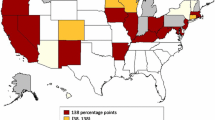Abstract
This study uses state-level data to identify key factors influencing geographic differentials in the percentage of the population without health insurance coverage, with particular emphasis placed on the impact of the percentage of the population that is either self-employed or independent contractors. Not surprisingly, the cross-section analysis finds that the percentage of a state's population without health insurance was a decreasing function of median family income in the state, the female labor force participation rate in the state, and the percentage of the state's population age 65 and older, while being an increasing function of the percentage of households in the state with only a female head of household present (no husband present) and the percent of the state's population classified as Hispanic. Reflecting the emphasis in this study, the empirical estimates all also reveal that the percentage of a state's population without health insurance is an increasing the percentage of the state's population that filed a federal personal income tax return that included a Schedule C, which is used in this study as a proxy for self-employment and independent contractors.
Similar content being viewed by others
References
Bopp, A. “Insurance Theory and the Medically Uninsured,” Atlantic Economic Journal, 33 (4), 2005.
Burstin, H. R. et al. “The Effect of Change of Health Insurance on Access to Care,” Inquiry, 35 (4), 1998–1999, pp. 389–97.
Chirikos, T. N. “Further Evidence That Hospital Production is Inefficient,” Inquiry, 35 (4), 1998–1999, pp. 408–16.
Cutler, D. M. “A Guide to Health Care Reform,” Journal of Economic Perspectives, 8 (3), 1994, pp. 13–29.
Daniels, M. J.; Gatsonis, C. “Hierarchical Generalized Linear Models in the Analysis of Variations in Health Care Utilization,” Journal of the American Statistical Association, 94 (445), 1999, pp. 29–42.
Dushi, I.; Honig, M. “Price and Spouse's Coverage in Employee Demand for Health Insurance,” American Economic Review Papers and Proceedings, 93 (2), 2003, pp. 252–256.
Gaynor, M.; Haas-Wilson, D. “Change, Consolidation, and Competition in Health Care Markets,” Journal of Economic Perspectives, 13 (1), 1999, pp. 141–64.
Given, R. S. “Economies of Scale and Scope as an Explanation of Merger and Output Diversification in the Health Maintenance Organization Industry,” Journal of Health Economics, 15 (4), 1996, pp. 685–713.
Glied, S. “Health Care Costs: On the Rise Again,” Journal of Economic Perspectives, 17 (2), 2003, pp. 125–48.
Goodman, A. C.; Stano, M. “HMOs and Health Externalities: A Local Public Good Perspective,” Public Finance Review, 28 (3), 2000, pp. 247–69.
Gruber, J. “Evaluating Alternative Approaches to Incremental Health-Insurance Expansion,” American Economic Review Papers and Proceedings, 93 (2), 2003, pp. 271–76.
Harris, K. M.; Keane, M. P. “A Model of Health Plan Choice: Inferring Preferences and Perceptions from a Combination of Revealed Preference and Attitudinal Data,” Journal of Econometrics, 89 (1–2), 1999, pp. 131–157.
Hart, L.; Wagner, E.; Pirzada, S.; Nelson, A. F.; Rosenblatt, R. “Physician Staffing Ratios in Staff-model HMOs: A Cautionary Tale,” Health Affairs, 21 (1), 1997, pp. 55–70.
Holahan, J.; Nichols, L. M.; Blumberg, L.J.; Shen, Y.-C. “A New Approach to Risk-Spreading via Coverage-Expansion Subsidies,” American Economic Review Papers and Proceedings, 69 (2), 2003, pp. 277–82.
Internal Revenue Service. IRS Data Book, Washington, District of Columbia: U.S. Government Printing Office, 2002.
Jordan, W. J. “An Early View of the Impact of Deregulation and Managed Care on Hospital Profitability and Net Worth,” Journal of Healthcare Management, 46 (1), 2001, pp. 161–71.
Karsten, S. G. “Health Care: Private Good vs. Public Good,” The American Journal of Economics and Sociology, 54 (2), 1995, pp. 129–44.
Koch, J. V.; Cebula, R. J. “A Note on Smoking Health Costs and Public Policy,” The American Journal of Economics and Sociology, 51 (2), 1992, pp. 159–60.
Marstellar, J. A.; Nichols, L. M.; Badawi, A.; Kessler, B.; Rajan, S.; Zuckerman, S. Variations in the Uninsured: State and County Analyses, Research Report, Urban Institute, Washington, District of Columbia, 1998
Newhouse, J. P. “Symposium on Health Care Reform,” Journal of Economic Perspectives, 8 (3), 1994, pp. 3–11.
Okunade, A. A. “Cost-output Relation, Technological Progress, and Clinical Activity Mix of U.S. Hospital Pharmacies,” Journal of Productivity Analysis, 16 (1), 2001, pp. 167–93.
—. Are Factor Substitutions in HMO Industry Operations Cost Saving?” Southern Economic Journal, 69 (4), 2003, pp. 800–21.
Olsen, R. N. “The Reform of Medical Malpractice Law: Historical Perspectives,” The American Journal of Economics and Sociology, 55 (3), 1996, pp. 257–75.
Swartz, K. “Markets for Individual Health Insurance: Can We make Them Work with Incentives to Purchase Insurance?” Inquiry, 38 (2), 2001, pp. 133–45.
—. Reinsuring Risk to Increase Access to Health Insurance,” American Economic Review Papers and Proceedings, 69 (2), 2003, pp. 283–87.
U.S. Census Bureau. Statistical Abstract of the United States, 2001, Washington, District of Columbia: U.S. Government Printing Office, 2001.
—. Statistical Abstract of the United States, 2002, Washington, District of Columbia: U.S. Government Printing Office, 2002.
—. Statistical Abstract of the United States, 2004–2005, Washington, District of Columbia: U.S. Government Printing Office, 2005.
White, H. “A Heteroskedasticity-Consistent Covariance Matrix Estimator and a Direct Test for Heteroskedasticity,” Econometrica, 48 (3), 1980, pp. 817–38.
Author information
Authors and Affiliations
Corresponding author
Rights and permissions
About this article
Cite this article
Cebula, R.J. A Further Analysis of Determinants of Health Insurance Coverage. Int Adv Econ Res 12, 382–389 (2006). https://doi.org/10.1007/s11294-006-9025-3
Received:
Accepted:
Published:
Issue Date:
DOI: https://doi.org/10.1007/s11294-006-9025-3




